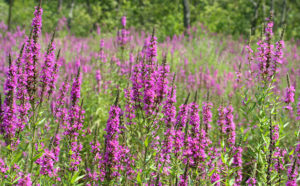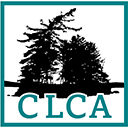
Lythrum salicaria & Lythrum virgatum
Purple loosestrife is native to Europe and Asia where insects and diseases native to that area have kept it in check. It was introduced to North America as a garden plant but has since spread to wild areas and depleted natural habitat for native plants and animals. Cultivars of loosestrife are still sold as garden plants in some parts of the U.S. However, Wisconsin law bans the sale, distribution, planting or cultivation of non-native purple loosestrife. Some plant producers claim to have sterile varieties of purple loosestrife. It appears that cultivars are capable of producing seeds if they cross-pollinate with another loosestrife plant.
Description: Purple loosestrife has angled 20-59 inch (50-150 em) tall stems that emerge from a woody rootstock. Lance-shaped 1-4 inch (3-lO cm,) long leaves attach directly to the stem, and often have fine hairs on their surface. The leaves may be opposite, in whorls of three, or spiraled around the stem. This seems to be related to the number of sides on a stem: four-sided stems have opposite leaves, five-sided stems have leaves in a spiral arrangement, and six-sided stems have leaves in whorls. All three stem types can be found on a single loosestrife plant. Clusters of magenta flowers are produced in leafaxils on a terminal spike. Each flower has 5-7 narrow petals 0.3-0.5 inches (7-12 mm) long that are wrinkled with a tissue paper consistency. The seeds produced are tiny but great in number. Mature loosestrife plants yield up to 2.7 million seeds per year that have the ability to remain viable in the soil for years before germination.
Habitat: Purple loosestrife can be found in a wide variety of sites from moist soil to shallow water and specifically near or in marshes, wetlands, streams, rivers, or lakes. Disturbed sites, along highways for example, also create an opening for germination of seeds and expansion of new colonies. Loosestrife can overtake a natural habitat and literally choke out the native vegetation, including rare or endangered plants. In addition, the wildlife that depend on the native vegetation for food or shelter are forced out of the area because loosestrife provides little food or habitat for native wildlife species.
Similar Species: There are several species of native flowering plants that are often mistaken for purple loosestrife so it is important to correctly identify the plant in question before taking steps toward control. Native plants that are commonly mistaken for purple loosestrife include blazing-star/gayfeather (Liatris pycnostachya), fireweed (Epilobium angustifolium), blue vervain (Verbena hastata), winged loosestrife (Lythrum alatum), and swamp loosestrife (Decodon verticillatus).
Management and Control: Purple loosestrife can be controlled using mechanical, chemical, and biological means. The best treatment plan depends mainly on the size and density of the infested site. Small to medium, 0.1-2 acres (0.04-0.8 hectare) sites with low to medium density of loosestrife plants (1 – 60) are best managed using mechanical and selective chemical treatments. Herbicides kill all plants, so careful application is necessary and a permit is needed from the Wisconsin DNR before applying herbicides in or near waterbodies. Permit fees are waived for controlling purple loosestrife. Large sites with high density of loosestrife are best managed through means of biological control using Galerucella sp. beetles available through the WDNR.
Links for additional information:
